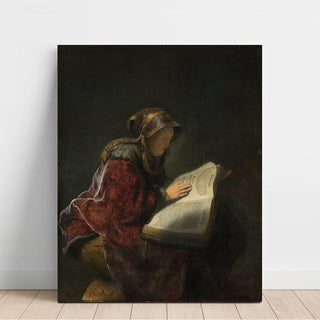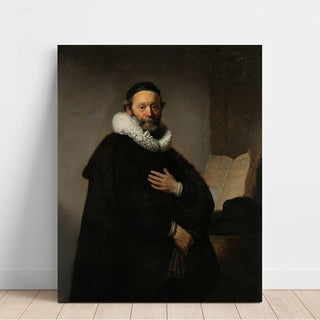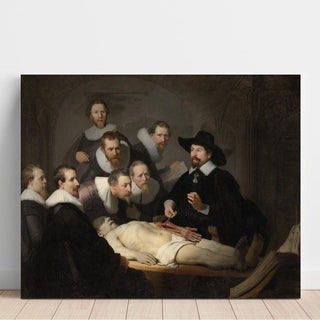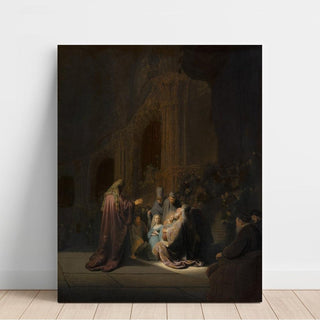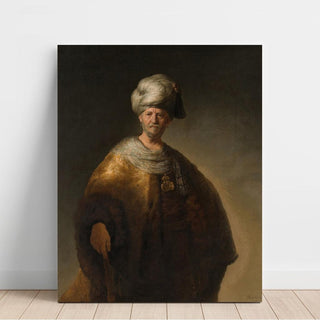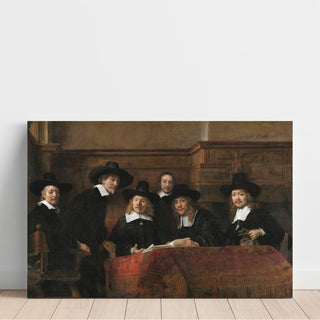Buy art prints: Rembrandt van Rijn
Discover our exclusive collection of art prints by Rembrandt van Rijn, an undisputed master of baroque painting. Each reproduced work delicately captures the magic of chiaroscuro and the psychological depth that characterize his art. Immerse yourself in the emotional intensity of his portraits and the narrative richness of his biblical scenes, to enhance your interior with a touch of authenticity and history. Our faithful art prints offer you the opportunity to admire at home the legacy of one of the greatest artists of the Dutch Golden Age.
Frequently asked questions about the career and legacy of Rembrandt van Rijn
Who was Rembrandt van Rijn?
Rembrandt van Rijn, born in 1606 in Leiden, is a Dutch painter and engraver recognized for his major role in the Dutch Golden Age of baroque painting. His work explores light, shadow, and human nature with an intensity rarely matched.
What are the main characteristics of his style?
His style is distinguished by an exceptional mastery of chiaroscuro, psychological depth in portraits, and innovative techniques, especially in engraving and printmaking.
What subjects did Rembrandt most frequently depict?
He mainly painted portraits, self-portraits, biblical and historical scenes, as well as engravings that demonstrate his technical virtuosity.
What is Rembrandt's impact on art history?
Rembrandt revolutionized the depiction of emotion and light, leaving a lasting influence on generations of artists and the evolution of Western painting.
Why are his works so highly prized?
The emotional richness, technical complexity, and universal scope of his subjects make his works highly sought-after pieces in public and private collections.
How has his personal journey influenced his art?
His personal experiences, marked by successes and trials, are reflected in the human depth and sensitivity of his paintings.
What are the must-see masterpieces of Rembrandt?
Among his major works are "The Night Watch," "Self-Portrait," "The Return of the Prodigal Son," and "Christ at the Column."
Why choose an art print of his paintings?
Art prints allow you to appreciate the beauty and emotional strength of his works in an accessible setting, while enriching your interior decor.
Summary of Rembrandt van Rijn's career
Rembrandt van Rijn is an iconic figure of the Dutch Golden Age, whose career spans over forty years. Trained in classical techniques in Leiden, he quickly developed a unique style blending technical innovation and profound humanity. His work is marked by a constant exploration of light and shadow, as well as a particular attention to the emotions and psychology of his subjects. Despite periods of success and recognition, he also faced financial and personal difficulties that fueled his art with poignant sincerity. His artistic legacy is immense, both through the quality of his paintings and his art prints that have influenced many artists.
Youth and training
Born in 1606 in Leiden, Rembrandt studied with local masters before settling in Amsterdam, where he experienced a rapid rise thanks to his portraits and historical scenes.
Mastery of chiaroscuro
He revolutionizes the use of light, creating striking contrasts that bring life and emotion to his compositions, a technique still studied today.
Exploration of the human condition
His portraits, notably his self-portraits, reveal rare introspection and an authentic representation of human feelings, between vulnerability and dignity.
Major works and biblical themes
Rembrandt excels in religious scenes, illustrating biblical stories with dramatic intensity and narrative sensitivity that captivate the viewer.
Heritage and influence
His style has profoundly influenced Western painting, inspiring both his contemporaries and modern and contemporary artists in their approach to light and emotion.
Why buy an art print of a Rembrandt van Rijn painting?
Choosing an art print of a Rembrandt painting is inviting a work full of meaning, history, and emotions into your home. These faithful reproductions reproduce the depth of chiaroscuro and the finesse of details that make the master's reputation. They offer an impressive visual rendering that enriches any living or working space, combining elegance and intensity.
These artistic products integrate harmoniously into your decor:
In a living room, they bring a warm and sophisticated atmosphere, ideal for a reception or relaxation area.
In a bedroom, they create an intimate and soothing setting, inviting reflection and emotion.
In an office, they inspire concentration and creativity through their depth and visual richness.
Beyond their beauty, these art prints are an invitation to cultural exchange and discovering one of the geniuses of painting.
An ambiance that elevates your decor
Rembrandt art prints create a unique atmosphere, blending classicism and dramatic intensity. They provide a perfect balance between light and shadow, creating a space filled with history and visual poetry.
A timeless art for your decoration
Rembrandt's works transcend eras without losing their power. Installing an art print by Rembrandt van Rijn is:
affirm a strong taste for classical art and culture;
bring a touch of elegance and refinement to your interior;
enjoy a work that sparks reflection and emotion;
valoriser un patrimoine artistique universel et reconnu.
Do you offer museum-quality printing?
Our art prints are produced with high-end printing techniques ensuring exceptional fidelity to the originals. Every detail, every nuance of light is accurately reproduced, for a rendering close to that of a museum-exhibited painting.
FAQ about our Rembrandt van Rijn collection
Are the art prints faithful to the original works?
Yes, we use advanced printing technologies to guarantee a faithful reproduction of the colors, textures, and details of Rembrandt's paintings.
What formats are available?
Our art prints are available in several formats suitable for different spaces, from small desk frames to large living room canvases.
Are the art prints delivered framed?
We offer options with or without a frame, according to your preferences and decorating needs.
Can art prints be personalized?
We offer customization options, including dimensions and printing supports.
What is the delivery time?
Delivery is generally made within one to two weeks, depending on the chosen options.
How to care for an art print?
A simple regular dusting with a soft cloth is enough to preserve the quality of the print.
Is it a good gift idea?
Absolutely, offering a Rembrandt art print is an elegant and cultural gift, appreciated by art lovers.
Are art prints suitable for all decorating styles?
Yes, their timeless character adapts just as well to classic as to contemporary interiors.
Our top 8 most famous art prints by Rembrandt van Rijn
1. The Night Watch (1642)
Iconic masterpiece, this scene of a civic militia is famous for its dynamism and masterful use of chiaroscuro.
2. Self-Portrait (1660)
A poignant testimony of the artist through the years, revealing his introspection and mastery of portraiture.
3. The Return of the Prodigal Son (1669)
A biblical scene full of emotion, illustrating compassion and forgiveness with remarkable intensity.
4. The Night Watch (1630)
A moment of everyday life depicted with realism and subtle lighting that highlights expressions.
5. Balthazar (1635)
Portrait of one of the Magi, blending symbolic richness and fine detail.
6. Christ at the Column (1631)
A dramatic depiction of the Passion, where the play of light emphasizes emotional tension.
7. The Jewish Bride (1667)
An intimate and warm portrait, celebrating love with tenderness and realism.
8. The Anatomy Lesson of Dr. Tulp (1632)
A famous group scene, combining scientific precision and dynamic composition.
Conclusion: Enhance your decor with Rembrandt van Rijn art prints
Offering your interior a Rembrandt art print is choosing to combine history, emotion, and timeless beauty. These works, rich in contrasts and humanity, bring a unique depth to any space. Whether you are an art enthusiast or simply looking for elegant and meaningful decoration, our art prints allow you to possess a fragment of Rembrandt's artistic genius at an accessible price.
Thanks to exceptional print quality, each art print faithfully reproduces the magic of chiaroscuro and the richness of details, for a rendering as impressive as an original. Let yourself be seduced by the expressive force and sophistication of Rembrandt's paintings, and transform your interior into a true art gallery.
Explore our collection now and choose the artwork that will reveal the full emotional and aesthetic power of this unparalleled master.

